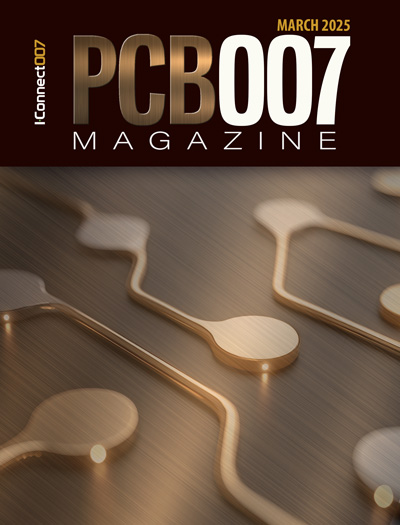-

- News
- Books
Featured Books
- pcb007 Magazine
Latest Issues
Current Issue
Voices of the Industry
We take the pulse of the PCB industry by sharing insights from leading fabricators and suppliers in this month's issue. We've gathered their thoughts on the new U.S. administration, spending, the war in Ukraine, and their most pressing needs. It’s an eye-opening and enlightening look behind the curtain.

The Essential Guide to Surface Finishes
We go back to basics this month with a recount of a little history, and look forward to addressing the many challenges that high density, high frequency, adhesion, SI, and corrosion concerns for harsh environments bring to the fore. We compare and contrast surface finishes by type and application, take a hard look at the many iterations of gold plating, and address palladium as a surface finish.

It's Show Time!
In this month’s issue of PCB007 Magazine we reimagine the possibilities featuring stories all about IPC APEX EXPO 2025—covering what to look forward to, and what you don’t want to miss.
- Articles
- Columns
Search Console
- Links
- Media kit
||| MENU - pcb007 Magazine
Observations on Palladium as a Final Finish
April 4, 2025 | Happy Holden, I-Connect007Estimated reading time: Less than a minute
Not much has been published about palladium as a final finish, but it’s experiencing a renaissance as a liquid metal for metallization of copper in ultra HDI and as a final finish. It was very popular in the 1970s because of its corrosion resistance, as the only other final finishes were tin-lead reflow, Ni/Au, OSP, or immersion tin. Palladium was very popular with the automotive industry then and Photocircuits of Glen Cove, New York, was a major supplier of boards.
Palladium Finish Used in Automotive and Electronics
Early in the 2010s, palladium started to reemerge as a final finish. Its advantages were:
- Eliminates black pad
- A single coating on copper
- Excellent silver replacement
- Short process time of 15 minutes
- Excellent shelf life
- Excellent solderability after multiple reflows
- Can be used to replace carbon switches
- When gold wire bonding is required
- Excellent replacement for harsh environments
- High gold bond shear test results
- Nonmagnetic for RF
- Better wear attributes than gold
To read this entire article, which appeared in the March 2025 issue of PCB007 Magazine, click here.
Suggested Items
EIPC Summer Conference 2025: PCB Innovation in Edinburgh
04/18/2025 | EIPCEIPC have very wisely selected this wonderful city in Scotland as the venue for their Summer Conference on June 3-4. Whilst delegates will be distilling the proven information imparted by the speakers in the day, in the evening they will be free spirits at the Conference Dinner.
Real Time with... IPC APEX EXPO 2025: Uyemura—Inside the Specialty Chemicals Market
04/03/2025 | Real Time with...IPC APEX EXPORich Depoto discusses Uyemura's focus on specialty chemicals and market trends, particularly the shift towards HDI and UHDI products. Rich highlights innovations in surface adhesion and micro etches for copper, essential for high-speed transmission.
Uyemura Announces Six Sigma Graduates
04/02/2025 | UyemuraDr. Patrick Valentine, Technical & Lean Six Sigma Manager and Six Sigma Master Black Belt, announces the completion of Lean Six Sigma Black Belt training by 4 members of Uyemura’s professional staff.
Real Time with... IPC APEX EXPO 2025: MKS' Atotech—Leading Innovations in Semiconductor Solutions
03/28/2025 | Real Time with...IPC APEX EXPOIn this interview, Marcy LaRont speaks with Kuldip Johal, CTO, MKS’ Atotech. Based in Boston, MKS operates in vacuum solutions, photonics, and specifically for the Atotech division, material solutions. MKS significantly impacts the semiconductor industry, supplying components for up to 85% of global semiconductor tools and covers processes and materials for 70% of PCB manufacturing steps.
Gold as a Key Component in PCBs and IC Substrates
03/20/2025 | Britta Schafsteller, Sandra Nelle, and Kuldip Johal, MKS' AtotechGold has long been a cornerstone in the electronics industry, particularly in the surface finishing of PCBs and IC substrates. It provides essential surface protection while enabling various assembling techniques, such as soldering connections and wire bonding, using aluminum, gold, or copper wires.


